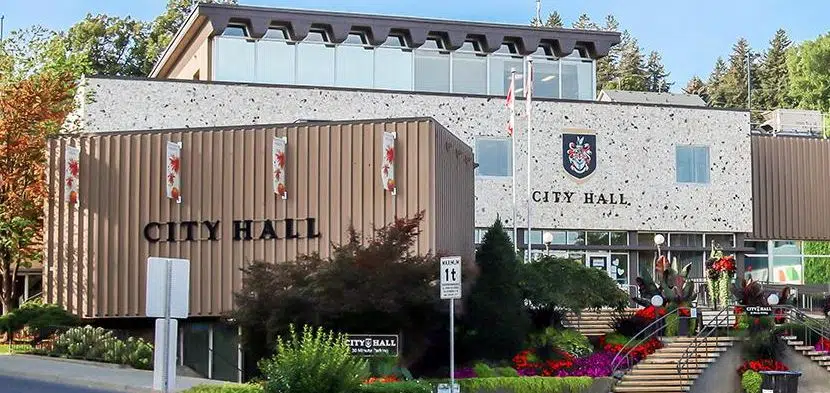
Kamloops City Hall. (Photo via City of Kamloops)
Kamloops City Council is moving ahead with plans to update how it informs residents and handles voter approval, giving initial approval to two new bylaws and a policy meant to improve transparency and efficiency — though the changes sparked debate over whether the city is doing enough to keep the public informed.
The push to modernize Kamloops’ public notification system and alternative approval process (AAP) policies comes just months after the City successfully defended itself in court over its use of the AAP to greenlight the $275 million Build Kamloops plan. That plan includes a new downtown Centre for the Arts, an arena complex in Dufferin, and other major recreational facilities. A BC Supreme Court petition filed by resident Katherine Wunderlich challenged the legality of the AAP, claiming voters weren’t given enough information. Although the City ultimately won the case — with Justice Joel Groves ruling Kamloops had met all legal requirements — the costly and high-profile challenge sparked renewed calls for clearer, more robust public engagement.
The changes, introduced by Denise Anderson, City of Kamloops deputy corporate officer during a presentation to council, involve the adoption of a new Council Policy for Alternative Approval Processes, a new Public Notice Bylaw, and amendments to the existing Council Procedure Bylaw. One major change proposed is allowing residents to electronically sign elector response forms, a first among the BC municipalities reviewed by staff.
“This policy was drafted to improve transparency and efficiency… and to establish processes for an alternative approval process that are not specifically outlined in the Community Charter,” said Anderson. “Our proposed policy actually allows for something that none of [the comparator municipalities] do, which would be [that] electors could electronically sign the elector response form.”
The proposed Public Notice Bylaw, brought forward after the closure of Kamloops’ last print newspaper in October 2023, would replace traditional newspaper ads with two primary mechanisms: the city’s official website and an email subscription service for public notices. These changes align with Community Charter Section 94.2 and follow models used by Coquitlam and Surrey.
But it was Mayor Reid Hamer-Jackson who steered much of the discussion into the realm of how—and how much—the city should spend on ensuring voters are informed, especially when large sums of public money are at stake. “Is there anywhere in there we could do a mail out to the property owners? A mail out?” Hamer-Jackson asked. “I think that would be really good… then they can’t say they didn’t know.”
Anderson emphasized that the proposed bylaw simply defines methods of notification, not advertising strategy. “That would certainly be council’s prerogative,” the presenter replied. “The policy is just outlining the procedures, not what can or can’t be done.”
Cost and scope, however, emerged as a concern among several councillors and staff. Mailing every property owner would be expensive, with estimates ranging from $45,000 to $55,000 for a single mail-out via Canada Post. “If we were to do a full mail-out to every resident for every single statutory notice… the expense would be significant,” Anderson warned.
Councillor Kelly Hall, citing experience in distribution logistics, supported that concern. “We’re probably in the neighbourhood of 40,000 homes… It would be between $45,000 and $55,000 just for one distribution,” he said.
The mayor responded by comparing that figure to the legal costs incurred during the last AAP legal challenge, suggesting that proactive mail-outs might reduce future risk and litigation. While no specific legal cost was confirmed during the meeting, Hamer-Jackson argued that the potential benefits of broader notice justify the investment. “If it cost $50,000 or $100,000 or $10,000 or whatever, that $40,000 mail-out is pretty inexpensive for fear of it happening again,” he said.
Others on council, including Councillor Katie Neustaeter and Councillor Dale Bass, voiced support for a more situational approach to expanded notices, such as adding inserts in quarterly utility bills for major AAP initiatives.
“It wouldn’t hurt to put something in everybody’s utility bill… That’s just one more opportunity,” said Councillor Bill Sarai.
Councillor Margot Middleton also pointed out the inefficiency of only mailing property owners, as renters—who may also be eligible electors—would be missed. “You’re still only reaching a percentage of voters… You’re not reaching all voters by any stretch, and probably not even close,” Middleton said.
The meeting concluded with council giving three readings to the new bylaws and acknowledging that specific communication strategies—like mail-outs—would be better addressed on a case-by-case basis during individual AAP or referendum planning.
As Councillor Mike O’Reilly summed up, “There’s no guarantee that future litigation won’t happen even if we do a 40,000 mail-out. These things should be considered by councils of the day, when the time comes.”















